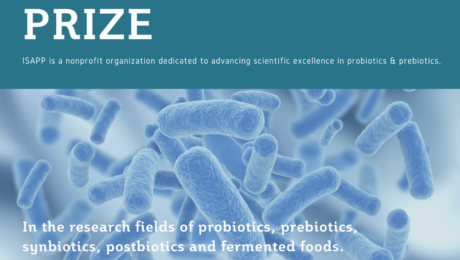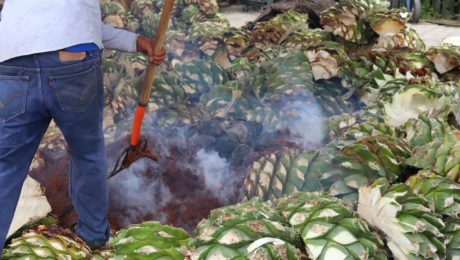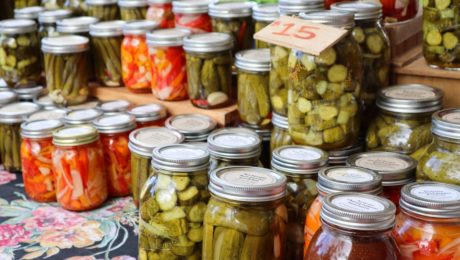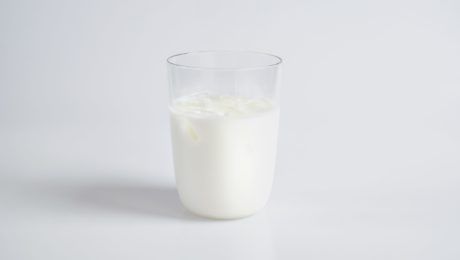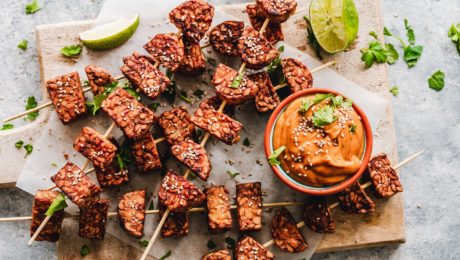FERMENTATION 2021 Wrap-Up
Nearly 300 individuals from around the world participated in The Fermentation Association’s first conference, FERMENTATION 2021. The virtual event included 35 educational keynotes, presentations, and panel discussions from more than 60 speakers over three days. Topics ranged from the science of fermentation to the art of fermenting to create flavor, from how fermented products are selling at retail to what’s next in the world of fermentation.
“I’ve been in this field for 40 years and, in all honesty, this is one of the biggest honors I’ve received, to be the speaker for this opening meeting of this really cool organization,” said Bob Hutkins, professor of food science at the University of Nebraska. Hutkins presented the conference’s opening keynote, Definition & History of Fermented Foods.
Over five years ago, John Gray, TFA’s founder, envisioned a trade show for producers of fermented foods and beverages, to make those artisanal items a more prominent part of the retail space. John connected with Neal Vitale, TFA Executive Director, and the organization was born out of their collective vision. TFA has grown, with a robust website, biweekly newsletter,a series of webinars and, now, an international conference. TFA has an Advisory Board that includes food and beverage producers, academics and researchers, and food and flavor educators and authors. TFA has formed working relationships with a number of other like-minded trade associations and organizations, and established a Buyers Council to create an active dialogue with food and beverage distributors, brokers and retailers.
“I have to tell you what a thrill it is to have you all here to witness and to participate in the beginning of a dream coming true,” added Gray in his welcoming remarks. Gray is the chairman and CEO of Katalina Holding Co., a food incubator and parent company of Bubbies Pickles.
FERMENTATION 2021 content paralleled TFA’s primary missions: first, help consumers better understand fermentation and its potential health benefits; second, work to improve health and safety regulations as they pertain to fermented products and third, connect the science and health research communities with producers, supporting scientific research and for a better understanding of the “state of the art.”
What made FERMENTATION 2021 unique is that it was the first event to bring together everyone involved in the world of fermentation — producers, retailers, chefs, scientists, authors, suppliers and regulators. The conference was not a how-to fermentation education event, as TFA feels there are numerous, effective resources for the person looking to, for example, make kimchi or learn about using koji.
“”We were delighted with how well FERMENTATION 2021 met — in fact, exceeded — our goals,” said Vitale. “While we were disappointed that the continuing impact of COVID-19 kept us from meeting in person, we were gratified by how all the participants responded, interacted, and engaged during our three jam-packed days. And, with recording of all our sessions now available online for our registrants, we expect that energy and excitement to continue.”,
“Fermentation is experiencing a major surge of interest in restaurants and kitchens around the globe,” says Amelia Nielson-Stowell, TFA Editor. “Our conference was a major milestone for the industry and we are already in the planning stages for FERMENTATION 2022 next summer. And, assuming we will be able to meet in person once again, we plan to host a tasting and sampling event for consumers alongside our conference.”
- Published in Business, Food & Flavor, Health, Science
The Brewing Coffee-Farming Crisis
Many pressures are building on coffee farmers, making their jobs increasingly difficult. Climate change is causing numerous impacts — temperatures are rising, rainfall is increasingly unpredictable, weather can swing from drought to flood, and new crop pests are emerging. And these problems are on top of existing environmental concerns, as growing coffee requires large amounts of water.
Further, studies show that, even with “modest declines of greenhouse gas emissions, about 50 percent of the land with conditions suitable for growing the two main species of coffee, arabica and robusta, which account for 99 percent of commercial supply, ‘could disappear by 2050.’ Brazil and Vietnam, major producing countries, would be especially hard hit.”
The Times details several organizations’ efforts to aid coffee farmers by restoring and protecting water resources, supporting more efficient use of water, improving crop yields with targeted fertilization and starting a global breeding network for new coffee species that can withstand tough climates.
Read more (The New York Times)
Glenn Gibson Early Career Researcher Prize
Applications are being accepted for the 2022 Glenn Gibson Early Career Researcher Prize, sponsored by the International Scientific Association for Probiotics and Prebiotics (ISAPP). The winner will receive $1,500 U.S. cash and an invitation to present at the 2022 ISAPP annual meeting. Click here for application details, due Nov. 19.
In 2021, ISAPP launched the Early Career Researcher Prize. As this initiative was spearheaded by ISAPP co-founder and longtime board member Prof. Glenn Gibson, this award was renamed to honor him: “Glenn Gibson Early Career Researcher Prize”. The intent of this award is to recognize excellence in research in early career researchers in the fields of probiotics, prebiotics, synbiotics, postbiotics or fermented foods.
- Published in Science
Analyzing Mexico’s Traditional Fermented Beverages
A research team has made the first comprehensive analysis of Mexico’s traditional ferments. Utilizing the country’s native cacti, agaves and maize, these diverse beverages are unique to their region. But they are poorly studied, and some are endangered as they fall out of style with younger generations.
“Many of Mexico’s finest microbiologists and ethnobotanists are giving ever-greater attention to this fascinating but once-forgotten foodscape, but even they are willing to admit that we’re just beginning to scratch below the surface of understanding all the biodiversity in these bottles of blessed ferment,” says Gary Paul Nabhan, research scientist at the Southwest Center of the University of Arizona (U of A).
Researchers in various disciplines (microbiology, ethnoecology and genetics) from five different schools (U of A and four universities in Mexico) took part in the study. The results, Traditional Fermented Beverages of Mexico: A Biocultural Unseen Foodscape, are published in the international journal Foods.
Sixteen traditional Mexican fermented beverages were identified: tepache, pulque, hobo, Mexican wines, colonche, nawait, pozol, sidra, tejuino, tesgüino, taberna, cocoyol, tuba, Mexican palm wine, balché and xtabentún. Those 16 drinks were made from 143 plant species and include 102 genre of microorganisms.
In each region, “a distinctive set of plant roots, leaves, fruits and stems were added as fermentation catalysts, flavorants, colorants and stabilizers,” reads the U of A press release. “A large number of bacterial strains and yeasts — in addition to common brewer’s yeasts and water kefir grains — enabled the nutritional transformation of these raw materials into a wide array of unique nutritionally rich, probiotic beverages.” The team mapped the regional variations and ecological niches of the fermented drinks.
Sustainable Future
The study notes this level of analysis is “indispensable” to promote fair trade and sustainable food production. Industrial mezcal, for example, has created a monoculture of blue agave, and farm labor often works in exploitative conditions.
“These products have been embedded as part of the daily lives of many people, including those currently marginalized rural or Indigenous groups,” the study reads. “The diversity of fermented products is an outstanding reservoir of genetic resources that has high potential to obtain secondary products such as extracts, enzymes, dyes, and others compound that can be involved in global markets and could help to solve problems such as hunger and poverty and may play a key role to reinforce cultural identity..”
Traditional Mexican fermented beverages also provide important nutrients for consumers as the globe battles a changing climate.“The naturally-occurring yeasts and kefir-like tibico grains found in association with prickly pear cacti, saguaro fruit, century plants and desert spoons (sotols) likely tolerate much higher ambient temperatures than those from the semi-arid highlands and wet tropical forests,” Nabhan explains.
Extinct Drinks
Some healthier artisanal drinks “have fallen out of fashion and face local or broad extinction,” the press release notes. In some areas of the country, these “forgotten ferments” are still used in the home, but not commercialized.
“Now that the days of Prohibition are over and there is a great need for arid-adapted crops with highly-efficient water use, some of these traditional agave and cactus varieties should be revived for the local production of healthful beverages,” Nabhan suggests. “In fact, traditional beverages such as tepache, tesguino and colonche have made a comeback in the Tucson, Arizona, region since it received recognition as a UNESCO City of Gastronomy. These traditional beverages are also being employed by mixologists in novel cocktails now being featured in nearly every state of Mexico.
- Published in Food & Flavor, Science
How Important is Consumer Education?
This is the second in a series of articles that TFA will be releasing over the next few months, analyzing trends from our Member Survey.
Fermentation is cloaked in mystery for many consumers — it’s bubbly, slimy, stinky and not always Instagram ready.
So how can fermentation producers appeal to potential consumers? What’s the best way to share fermentation’s flavor and health attributes?
In The Fermentation Association’s membership survey on industry trends, a better-educated consumer was identified as a priority. When asked what would foster increased consumption of fermented foods and beverages, the top item for nearly 70% of producers was greater consumer understanding of fermentation and familiarity with the flavors associated with fermentation.
“More than wanting to sell a product, I want people to know the information,” says Sebastian Vargo of Vargo Brothers Ferments (who is speaking at FERMENTATION 2021). The Chicago-based brand sells ferments like pickles, sauces and kombucha. “I believe preventative health starts with fermentation. I’m explaining the difference between a pickle you see on the shelf versus a pickle you see in the refrigerator. But I’m also teaching people to power up their pantry, sauce up their life with condiments.”
Health vs. Flavor
Producers say they struggle sharing fermentation’s benefits with consumers. There are not enough peer-reviewed scientific studies on many fermented products to be the basis for health claims.
“We feel a responsibility as a fermented food company to entice customers into trying these hugely beneficial and delicious products,” says Savita Moynihan, who owns SavvyKraut in Brighton, UK, with her husband Stevo. But, “with sauerkraut, it is generally understood that raw and unpasteurised kraut is good for you but once you try to elaborate on live culture vs probiotics it gets complicated, more than it needs to be.”
Can a brand claim to include probiotics? Producers feel that guidance is not clear.
“There is confusion here that we feel needs to be ironed out in order to loosen the reins so fermenters can promote their products and their benefits with much more confidence,” she adds.
Moynihan says that, when SavvyKraut sells at farmers markets and local shops, they try to communicate two main things to consumers. First, the health benefits, like enhanced vitamin and nutrient contents, increased fiber and an aid to a diverse gut and digestive system. Second, the delicious flavor.
“The process of fermentation really enhances the flavours and creates an entirely new type of flavour which can elevate any meal,” Moynihan adds.
Lack of Tastings Hurting Efforts
One of the best ways to familiarize consumers with fermentation is for them to taste a product — flavor is a great marketing tool. But COVID-19 has hurt these efforts. Producers are unable to stage in-store demonstrations, offer samples at farmer’s markets or host in-person events. This has been especially hard for kombucha brewers, says Hannah Crum(who is also speaking at FERMENTATION 2021), president of Kombucha Brewers International (KBI).
“We still have such a big part of the population who don’t drink kombucha or don’t even know about [it]; we still have a lot of work in education,” Crum says.
Joshua Rood, CEO of Dr Hops Hard Kombucha, confirms, adding: “It continues to be very difficult to grow our brand and the whole category without live events.”
“The inability to do live tastings in 2020 had a significant diminishing impact on our sales during the pandemic,” he continues. “One of our main distinctions as a brand is superior taste. Consumers, however, do not believe claims about that unless they experience it for themselves. Even now we are significantly hampered by the lack of large beer festivals and street fairs. An artisanal craft brand like Dr Hops needs those live interactions!”
The Knowledge Gap
Despite the lack of in-store tastings, experts at New Hope Network (producers of the Natural Products Expos) say brands have a great opportunity — now, more than ever, during the COVID-19 pandemic — to connect with their consumers.
New Hope’s 2021 Changing Consumer Survey found U.S. consumers are not satisfied with their current health. Only 8% say they’re “extremely satisfied” with their health today, compared with 20% in 2017. Nearly 80% of consumers understand that diet greatly influences their health (79%). But achieving good health is both a goal and a struggle for consumers — and this is where brands can step in.
“There’s a gap to be bridged,” says Eric Pierce, vice president of business development for New Hope Network, during a session “Understanding Your Consumers” at the most recent Expo East. “I see it as our opportunity and our responsibility to help consumers translate healthy intentions into healthy behavior, either in how we’re educating them in our stores, the products that we’re innovating or the ways we’re communicating. Getting better at communicating can help them with solutions.”
A consistent, transparent, well-communicated message — from product label to social media page to website — is important. Pierce says consumers quickly see past “shallow marketing claims.”
“Leave a trail of breadcrumbs people can find,” Pierce advises. “You don’t have to communicate everything all at once, but allow people to follow a trail to the deeper story. When consumers want to find that trail, if it’s not there, they’ll quickly write you off as shallow with unbacked claims.”
Amanda Hartt, market research manager at New Hope, suggests putting a QR code on a product label that links to the science backing the benefits of your ingredients. Or partnering with a registered dietitian on social media to highlight how to use your product as part of a healthy diet.
[To learn more about this topic, register for FERMENTATION 2021 to hear one of the keynote panels “Educating Consumers About Fermentation.”]- Published in Business, Food & Flavor, Science
How Can Brands Educate Consumers on Alt Protein?
Alternative protein companies need to stop advertising their brand as the most ethical choice and instead appeal to consumer’s taste buds.
“Sometimes plant-based food companies don’t really market themselves as food,” says Thomas Rossmeissl, head of global marketing for Eat Just, Inc., which develops plant-based “eggs” and cell-cultivated meat. “There’s this inclination to talk about mission. We say ‘We’re good for the planet,’ ‘It’s good for you,’ ‘It’s good for animals’ and obviously that’s all true and it’s admirable and it’s what drives me in our company. But it can come off like we’re sort of apologizing, that we’re negotiating with consumers, that a consumer is sacrificing something delicious to get something ethical or healthy.”
“People not buying (traditional)meat and cheese because an animal was killed or tortured. They buy because it tastes great.”
Irina Gerry concurs. Gerry is the chief marketing officer for Change Foods, an animal-free dairy brand that will launch their product in 2023. Alternative protein brands need to “flip the script from plant-based, rationalizing the food choices.” Brands need to help consumers feel that purchasing an alternative protein is a “natural choice rather than a sacrifice.”
The two spoke on a panel Insights on Consumer Perceptions of Alternative Proteins at the virtual Good Food Conference. The conference is put on by the Good Food Institute, an international nonprofit that promotes plant- and cell-based meat.
Wide Consumer Base Wanting Animal-Free
Animal-free is the main driver for customers to buy alternative products. The alternative protein industry is not just marketing to vegans, they’re also selling to flexitarians and omnivores concerned about welfare. Ninety-four percent of Eat Just consumers consume some type of animal protein.
“Sustainability is skyrocketing and potentially could cross over health as the main motivator, especially in the younger population,” Gerry says.
The modern American household family fridge is divided. There may be three types of eggs in there — conventional, cage-free and plant-based — and three types of milk — dairy milk, almond and oat. Consumers as young as 12 are the ones educating themselves on alternative proteins.
“We’re going to see this younger generation drive families to plant-based solutions,” Rossmeissl says.
Staying Honest, Maintaining Trust
Transparency will be central to public adoption. Laura Reiley, a reporter for The Washington Post who moderated the panel, noted “there hasn’t been tremendous transparency” with the alt protein market. She’s written about the market since its beginning and notes, because there’s intellectual property and so much research and development dollars, most companies have kept their food shrouded in mystery.
“We don’t want to sort of follow the example of the conventional industry. We can do better than that,” Rossmeissl says. “On the cultivated side, we have a huge responsibility to get this right. Not just as a company but as an industry, we can’t screw this up.”
Perceived unnaturalness by consumers of alt protein is a challenge. Using the term lab-grown “is disparaging to us as an industry” he continues, “but I think the best way we can address that is by being really honest and what’s in it and how it’s made.”
Gerry notes 90% of dairy cheese sold globally is made with non-animal remnants through precision fermentation — and that’s been the predominant way traditional cheese is made for over 20 years. It’s the same technology Change Food’s animal-free cheese uses.
“(These traditional cheeses) made through precision fermentation, they’re labeled under natural and oftentimes organic cheese products and nobody’s grown a third leg and nobody’s freaked out, right?” Gerry continues. “But now we’ve added one more element of that cheese — removing the cow from the cheese — and everybody seems to be greatly concerned.”
Primeval Poop Profiles
Studies of ancient poop found “humans as long as 2,700 years ago in the Iron Age were already using sophisticated techniques in flavoring the fermented foods.” They especially loved pairing pale ale with blue cheese.
A paper published in Current Biology detailed how researchers used paleo fecal samples found in salt mines in Austria to analyze the food ancient people were consuming. Their stool dehydrated in the salt, creating an ideal, preserved sample.
Researchers from the Institute for Mummy Studies, the University of Trento and the Vienna Museum of Natural History also found industrialization transformed the Western diet. Humans used to have healthier, more biodiverse gut microbiomes “because they were eating unprocessed foods.”
Frank Maixner, one of the paper’s lead authors, believes combining archaeology and microbiology could “illuminate the greater puzzle of human history.”
Read more (Popular Science)
- Published in Food & Flavor, Science
Dairy Alternative from Fermented Pea & Rice
Researchers have discovered a milk alternative: fermenting pea and rice with probiotic strains. This dairy-free mixture is highly digestible and has the same animal protein as found in milk, casein.
Fermentation was critical to the results. Plant-based proteins are poorly digested because they are often insoluble in water, explains Professor Monique Lacroix of Institut National de la Recherche Scientifique (INRS). Animal proteins, in contrast, “usually take the form of elongated fibers that are easily processed by digestive enzymes.” But lactic acid bacteria in the fermented pea and rice drink predigested the proteins, improving digestibility.
“Fermentation allowed for the production of peptides (protein fragments) resulting from the breakdown of proteins during fermentation, facilitating their absorption during digestion,” notes an article on the research in Nutrition Insight.
INRS partnered with probiotics company Bio-K+ on the research. Their findings were published in the Journal of Food Science.
Read more (Nutrition Insight)
- Published in Science



